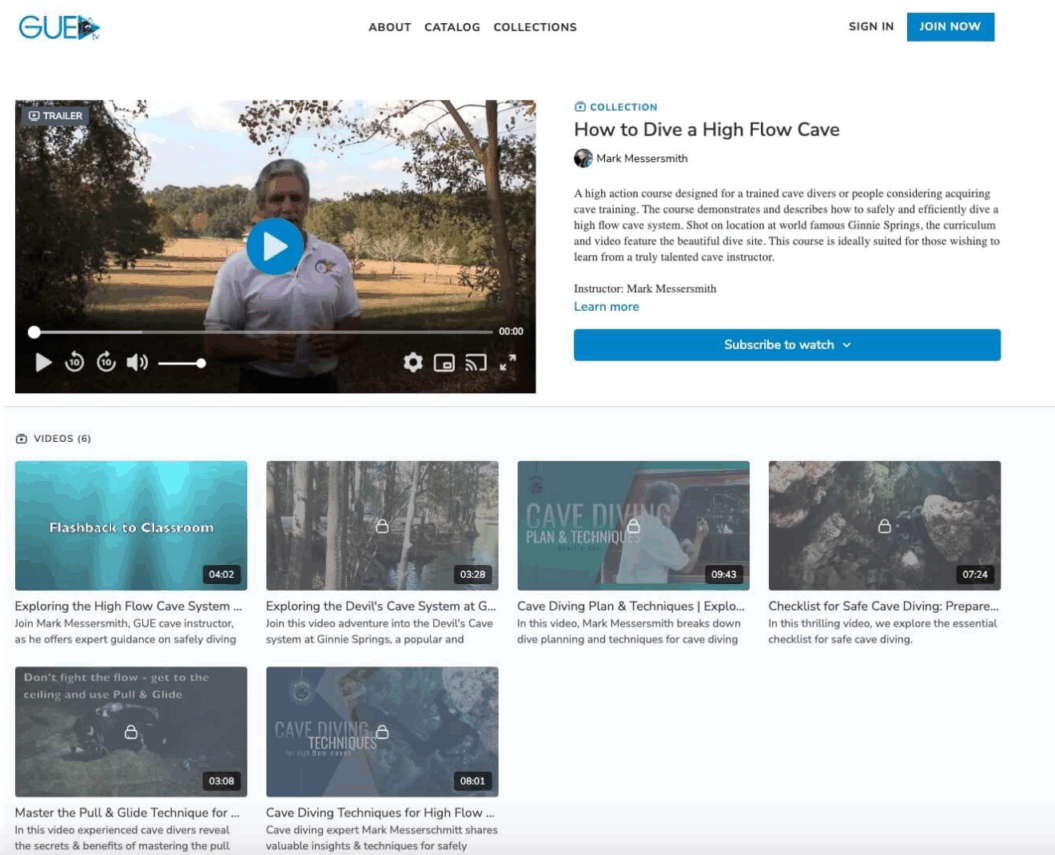You know your stuff as a creator — whether it’s yoga, baking, or teaching dance moves — but turning that expertise into a course that actually sells? That’s where most creators get stuck.
It’s frustrating to spend hours creating content only to see little sales or engagement. The good news? Successfully selling an online course isn’t a secret; any creator can do it with the right strategy to grow your online course business.
This article is your roadmap, packed with actionable tips and real-life examples to help you learn how to sell online courses that actually make money.
Let’s get into it!
How to sell online courses in 6 steps
From defining your audience to marketing your course, these 6 steps cover how to create and sell online courses.
1. Clearly define your target audience and “true fans”
If you’re already creating educational videos, you probably have an audience on YouTube, Instagram, or TikTok.
That audience breaks down into a few different types of viewers:
- Engaged fans watch your content occasionally.
- Advocate fans follow your journey and will sometimes buy.
- True fans support everything you create and want more.
Your goal is to create an online course for those true fans. They will buy all your courses and are most likely to benefit from them.
To do that, figure out:
- Who your true fans are
- What topic they need help with most
For example, GUE.tv knows their true fans are passionate about advanced diving, so they created a course on how to dive a high-flow cave. It’s niche, but that’s the point; your best topics may feel too specific for outsiders but perfect for your audience.
If you’re unsure what to cover, ask your community directly. Tools like forms or even group chats can reveal exactly what your fans want to learn.

Pro tip: Engage directly with your true fans to uncover their biggest pain points. This ensures your course solves real problems and drives strong sales.
2. Create your course content
Now that you know what topic your course needs to be about, it’s time to start creating. Here are a few universal tips around structure and course creation to help you craft your course:
- Pick an engaging title: A bland title like “Urban Gardening Course” won’t stand out, but something like “Master Your Green Thumb: Urban Gardening Techniques for Spring” instantly shows the value. Strong titles highlight the benefits, stay concise, and make the outcome clear. Test different options with your audience to see what resonates most.
- Organize your course content: Start with your students’ end goal and work backward to design your course. Break content into modules and lessons that build on each other, adjusting for course type, cost, and time. This step-by-step approach guides students toward mastery without overwhelming them.
- Determine the course format: Next, decide the best way to present your course. Video is often best for intensive or higher-priced programs, but the right format depends on your audience; ask what they prefer, whether it’s video, text, or a cohort-based course. Whatever you choose, keep lessons short (10-15 minutes) and focused.
Pro tip: Focus on creating actionable, bite-sized lessons that guide students step by step. Testing your format and title with a small group can boost engagement and completion rates.
3. Pick an online course platform that aligns with your goals
Most people writing guides on selling online courses would include an entire breakdown of the best online course platforms in this one step of the article.
We’ve added an entire course creation platforms comparison section later in this article for you to look at. You can click the link here to skip ahead to it.
Pro tip: Choose a platform that fits your long-term goals, not just your immediate needs. Consider factors like ease of use, video monetization options, and built-in community features to support growth.
4. Set a price that works for you and your audience
It’s easy to slap a price on your course and call it a day. But if you want to get paid your worth, pricing strategically is key. Beyond knowing if you’re charging enough, you also need to cover costs like:
- Content creation
- Software
- Marketing
- Payment fees
- Taxes
The easiest way to price your course is to start with an income goal and use our online course pricing calculator. Just input details like your revenue goal, audience size, conversion rate, costs, and competitor pricing, and you’ll get a recommended price.

Pro tip: Offer both memberships and one-off course sales. This helps you reach more learners and diversify your income, like Filmmakers Academy, which lets customers pay for a single masterclass or subscribe for full library access.

5. Improve your course’s value by offering community
At the core of any good course is a strong community. One of the first places a new customer will look for is an attached community area. This could be a Facebook group, or something on your course platform, like the community features Uscreen offers.
Even though your content and your offer will be what draws people in, it’s your community that will keep them coming back for more. So, it’s important to keep it in mind when you design your course.

When members feel connected, they’re most likely to renew their membership or explore your other digital products.
For example, M/BODY uses the live chat feature of their community area to create a clear reason for people to come back and consume more of their content.
With the live chat feature, members can connect directly with M/BODY’s founder, Marnie, and each other. They come early to talk and hang out afterwards, while Marnie’s team can answer questions about workout modifications in real time. This increases customer satisfaction and retention, and brings the M/BODY community closer together.
Your community also becomes a great sales tool if you want to build into the membership business model further down the line. All of the content and interaction can help you create content and generate sales by:
- Showcasing your member area
- Sharing quotes and testimonials
- Promoting community challenges
- Spotlighting customer results
Pro tip: Communities open the door to multiple monetization models. You can bundle them with one-time course sales, offer them as a premium upsell, or use them as the foundation of a recurring membership business.
6. Market and sell your online course
Your business needs students to thrive. To get customers, you need to market your online course. The goal here is to build relationships with potential students and encourage them to buy your course or sign up for a membership.
Here are a few ways to market your online course:
- Create a beautiful website: An online course platform helps you create a professional website that makes sales. With Uscreen, you can customize your website colors, images, fonts, and CTAs using a drag-and-drop website builder.
- Social media marketing: Be vocal on YouTube, LinkedIn, Instagram, TikTok, and other platforms you use to promote your new course and drive traffic to your site.
- Create sales funnels: Build your email list and capture lead information through giveaway funnels. Send discounted offers for the first month of their subscriptions.
- Run “refer a friend” campaigns: Give fans a custom referral link they can share with friends and family. When the referee signs up and pays for their subscription, the referrer gets a month free.
- Send abandoned cart emails: Encourage potential students to come back with a customized email. You can set up a 3-part email automation sequence in Uscreen with a discount offer to incentivize the sale.
- Offer a free trial: Let people try your membership website for a limited time. A free trial helps convince them your content is a good fit and can improve course sales.
- Reduce churn: Find out why students cancel their membership. If people are canceling because it’s too expensive, you can offer a discount to stick around. You can set up a win-back email series in Uscreen to recover lost subscribers automatically.

Pro tip: Focus on building relationships and providing value before asking for a sale. Knowing where to sell online courses and engaging your audience consistently will boost conversions and long-term retention.
Selling online courses considerations
Online courses have been a staple of making money online for a long time. They started as a side hustle hack, which creators eventually turned into fully fledged, profitable businesses. That’s led the current market to be predicted to reach revenues of $60.25 billion.
And, they’re still a great way to share your expertise and make money online. But, they come with their own set of challenges, like:
- They’re often a one-time payment: You’re constantly on the hunt for new customers, which can be exhausting.
- Content in online courses is usually static: Once it’s created, it doesn’t change, which can make it less appealing over time.
- They’re (often) missing an element of connection: Online courses can feel pretty impersonal because there’s a level of separation between you and your audience, which isn’t what a lot of customers are looking for nowadays. Creator economy trends show a desire for community and connection over just content. For example, almost 70% of consumers prefer brands that offer an online community.

However, online courses offer a superb way to create a proof of concept for a membership business. Selling a course is often the entry point into a more profitable, sustainable business.
How Justin Simon turned a $199 course into a sustainable membership
Justin Simon, a marketer turned course creator, built his first product around content repurposing: a $199 course called The Content Repurposing Roadmap. With about 250 students, it generated roughly $50,000 in revenue — a solid start but not enough to sustain a full business.

To grow, Justin shifted to a membership model with Distribution First, a $199-per-quarter club for marketers that offers ongoing content, webinars, office hours, and a thriving community.
While memberships may attract fewer buyers, the recurring revenue compounds over time; 60 subscribers could match his $50,000 course revenue, but in a more predictable, long-term way.
Online courses can be a great starting point, but pairing them with a membership creates a more stable and scalable business model.

Key takeaway: A one-time course launch can give you quick wins, but recurring memberships are what make money selling courses sustainable over the long run.
What is the best platform to sell an online course?
We’ve covered the how; now let’s talk about the where. If you want to make money selling courses, choosing the right online course platform is key.
Every creator has different needs. A YouTuber selling science classes to parents won’t need the exact same setup as an influencer monetizing pottery tutorials. But there are 4 things every course creator should look for when picking a platform:
- Ease of use: Both you and your students should find the platform simple to navigate.
- Features: Look for tools that fit your teaching style, whether that’s quizzes, certificates, or just straightforward video hosting.
- Pricing and monetization: Compare costs and selling models (one-time sales, subscription business models, or transaction fees) to see what aligns with your business goals.
- Customization: Make sure the platform lets you match your brand, either with drag-and-drop tools or more advanced coding options.
Keep all of these in mind as you explore the list below. It’ll help make the right decision a lot easier for you.
| Platform | Best for | Key benefits |
| Uscreen | Scaling your online course to a membership site | – Build your own exclusive community that boost your revenue. – Add a video library of online courses and content to deliver more value. – Create your own branded apps to deliver more value. |
| Thinkific | Course creators who are just starting out | – Add your own branding with a website builder. – Access marketing tools and a community function. – Easily manage all your courses, content, and analytics from the dashboard. |
| Mighty Networks | Online communities | – Deliver courses with group discussions and one-on-one interactions. – Set your community up quickly with AI functionality. – Use a wide variety of engagement tools, like online events, group discussions and polls. |
How to make your online course successful
Launching your course is a big milestone. But success doesn’t stop at launch. To keep growing and delivering value to your students, you’ll need to stay engaged, refine your approach, and actively drive results.
Here are some steps you can take to ensure your course thrives post-launch:
Focus on building an engaged community
Start a conversation with your members and provide encouragement to keep them engaged with your course content. The average completion rate for self-paced online courses is only 3%-6%.
The key to making your online course a success isn’t just making the ideal number of sales — it’s proving its value and generating that all-important social proof from the people who have completed the course and learned something valuable from it.
- Send out regular communications: Ask how your community is doing with the course materials, whether they need help, or simply to celebrate their progress. Encourage them to post within the community about the milestones they’ve achieved so far.
- Host a live session to cover key problems: This allows you to build a closer connection with your members, showing that you’re prioritizing their concerns or the areas they need extra help with while providing valuable one-on-one time.
- Set assignments or challenges: Post a challenge or assignment in the community to boost motivation. You could even turn it into a competition. For example, posting a photo of their progress, sharing favorite energy boosting snacks, or song ideas for a motivation playlist.
Gather feedback from your members
Find out what is, or what isn’t, working for your members. You can use these valuable insights to inform what you do next, whether that’s a follow-up course or adding to your existing one.
- Send out a member experience survey: After users have completed your course, send out a survey to find out how useful they found your content. Try to make it as specific as possible without overloading them with too many questions.
- Reach out to non-engaged users: Get feedback from users who have stopped engaging with your course. Touching base to find out what you could do better or if there’s additional support needed to keep them motivated not only helps to get them back on track but gives you actionable feedback you can use to build on.
- Gather reviews and testimonials: Reviews and customer stories are powerful marketing tools. They prove your course delivers value, and happy students are more likely to recommend you.
Plan your follow-up
Once you’ve launched your course and built your community, it’s time to think about what comes next. This could be the next level to build on your first course, a new subject altogether or revising and making your existing course better to relaunch it to new members.
- Put together a content plan: Research and plan new course content based on what your audience finds most useful. For example, in a drawing course, you could focus on specific styles or materials, or create levels from beginner to advanced.
- Create, create, create: Now you can focus on the fun part, and that’s creating your next course. Building up a library of content is a good way to attract and keep users engaged, as it shows you’re giving them lots of value and that you’re someone they can keep coming back to learn from.
- Launch, or relaunch: Whether you’re launching a new course or revamping your current one, take the time to review your marketing strategy based on what you’ve learned post-launch so that you can maximize your reach and earning potential.
Turn your course idea into a thriving business
The online course industry is booming, but the old model of selling one-off access to content is losing steam.
If you’re going to create and learn how to sell online courses, use it as a springboard to a bigger, more successful membership business down the line.
And, if you want to build on one of the best online course platforms that supports that journey, check out Uscreen today.

FAQ
How much does it cost to create an online course?
Creating an online course can cost anywhere from $200 to over $10,000, depending on whether you do the work yourself or hire help. An all-in-one platform like Uscreen offers essentials for a fixed monthly price.
How long does it take to create an online course?
Creating an online course could take between one week and 3 months. There are a lot of factors that will influence this, including your own schedule, if you have a team working on it with you, what kind of content you’re producing, and the space, equipment, and budget you have available.
Can you make money selling an online course?
Yes! If you want to create online courses for money, the potential is huge; some creators earn 6 figures a year. On average, successful courses bring in $1,000-$10,000 a month, though results vary. Shifting to a subscription model can boost profits with recurring revenue.
Why sell online courses?
Selling online courses is a great way to share your expertise with the world and build an active, engaged community who are willing to pay to learn from you. There isn’t a limit on how much you can earn from selling online courses, so it opens up the potential to make a living from sharing your passion and unique expertise with others.
What niche audience should I target to maximize course sales?
Target a niche audience that’s passionate, underserved, and willing to pay for specialized knowledge. The more specific you get, the easier it is to stand out and attract true fans who will buy your courses.
Do you need a license to sell courses online?
In most cases, you don’t need a license to sell courses online. However, depending on your business setup, you may need a standard business license, tax registration, or permits required in your country or state.








